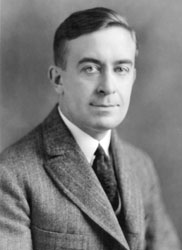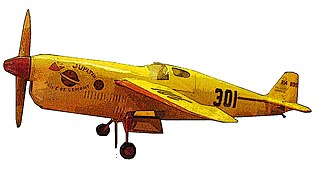
Formula V Air Racing is an American motorsport that involves small aircraft using engines up to 100 cubic inches (1.6 litres) in displacement.

Formula V Air Racing is an American motorsport that involves small aircraft using engines up to 100 cubic inches (1.6 litres) in displacement.
The proposal for Formula V has its roots in the 1964 Reno Air Races. [1] In 1969, Air racer, Steve Wittman presented at the Rockford air convention of the Experimental Aircraft Association specifications for a racing event based around aircraft powered with a Volkswagen air-cooled engine. [2]
Racers compete around a 2-mile oval course that subject the racers to up to 2.2g.
Several aircraft were capable of meeting the specifications for Formula V at its creation. Specific designs were introduced shortly after that maximized speed for the configuration.
Aircraft include:

Winners of the Formula V National Championship are determined by points from the years events. Since 1995 the winner also holds The Wittman Trophy for a year. [4]

Air racing is a type of motorsport that involves airplanes or other types of aircraft that compete over a fixed course, with the winner either returning the shortest time, the one to complete it with the most points, or to come closest to a previously estimated time.
Sonex Aircraft, LLC is an American kit aircraft manufacturer located in Oshkosh, Wisconsin, producing kits for four all-metal homebuilt monoplanes. The company was founded in 1998 by John Monnett, who has designed the Monnett Sonerai sport aircraft series, Monnett Monerai sailplane, Monnett Moni motorglider, and Monnett Monex racer. Monnett designs are displayed in the Steven F. Udvar-Hazy Center of the National Air and Space Museum near Washington D.C.

The Gee Bee Model R Super Sportster was a special-purpose racing aircraft made by Granville Brothers Aircraft of Springfield, Massachusetts at the now-abandoned Springfield Airport (Massachusetts). Gee Bee stands for Granville Brothers.

The National Air Races are a series of pylon and cross-country races that have taken place in the United States since 1920. The science of aviation, and the speed and reliability of aircraft and engines grew rapidly during this period; the National Air Races were both a proving ground and showcase for this.

The Ford Reliability Tour, properly called "The National Air Tour for the Edsel B. Ford Reliability Trophy", was a series of Aerial Tours sponsored in part by Ford from 1925 to 1931 and re-created in 2003. Top prize was the Edsel Ford Reliability Trophy. Henry and Edsel Ford were shareholders in the Stout Engineering Company. In August 1925, they purchased the entire company, making it the Stout Metal Airplane Division of the Ford Motor Company. Their product, the Stout 2-AT Pullman, was a featured plane. The plane was also used by their new airline the Ford Air Transport Service, which started regular flights in April. The Flights out of Ford Airport (Dearborn) cross-marketed, and showcased Ford's new interest in aviation.

Sylvester Joseph "Steve" Wittman was an air-racer and aircraft engineer.

The King's Cup Race is an annual British handicapped cross-country air race, is run by the Royal Aero Club Records Racing and Rally Association and was first contested on 8 September 1922. The event was open to Commonwealth pilots only.

The Sonerai is a small, VW-powered homebuilt aircraft, designed by John Monnett. The Sonerai began to compete as a single-seat, mid-wing, tailwheel Formula-V racer class formed in 1972. The Sonerai soon evolved into a two-seat model called the Sonerai II.

The Sharp DR 90 Nemesis is a Formula One racing aircraft designed by Jon Sharp and built at the Mojave Airport by the Nemesis Air Racing Team. The aircraft is powered by a modified Continental O-200 piston engine.

Alfred Victor Verville was an American aviation pioneer and aircraft designer who contributed to civilian and military aviation. During his forty-seven years in the aviation industry, he was responsible for the design and development of nearly twenty commercial and military airplanes. Verville is known for designing flying boats, military racing airplanes, and a series of commercial cabin airplanes. His planes were awarded with the Pulitzer Speed Classic Trophy in 1920 and 1924.

The Wittman V-Witt also called Witts V and Witt's Vee is single-engine tube-and-fabric construction aircraft specifically made for Formula V Air Racing.

Formula One Air Racing is an American motorsport that involves small aircraft using engines up to 200 cubic inches in displacement. Racers can reach speeds over 200 mph.

The Cessna CR-3 was a follow on racing aircraft to the Cessna CR-2 that raced in the 1932 National Air Races.

The Chester Jeep aka the Chester Special #1 was an air racer built by Art Chester for the 1932 National Air Races. The aircraft once held the world's speed record for aircraft at 237 mph (381 km/h).

The Folkerts SK-2, also known as Speed King Two, "Toots" and "Miss Detroit" was a racer built for the 1936 National Air Races

Chief Oshkosha.k.a.Buster is a homebuilt racing plane designed to compete in the 1931 American Cirrus Races.

The Wittman D-12 "Bonzo" was an air racer designed by Steve Wittman for the Thompson Trophy races. The aircraft's top speed of 325 mph (523 km/h) made it faster than any United States military aircraft of the era.

The Folkerts SK-3 a.k.a. "Jupiter, Pride of Lemont" was the third in a series of air racers developed by Clayton Folkerts.

The Wittman DFA aka Little Bonzo is a homebuilt racing aircraft designed to compete in midget racing.

The Nicholas-Beazley Pobjoy Special aka the Nicholas-Beazley Phantom I, aka the Wittman Phantom, aka the Flagg Phantom, aka the Reaver Special was a world record holding air racer of the 1930s